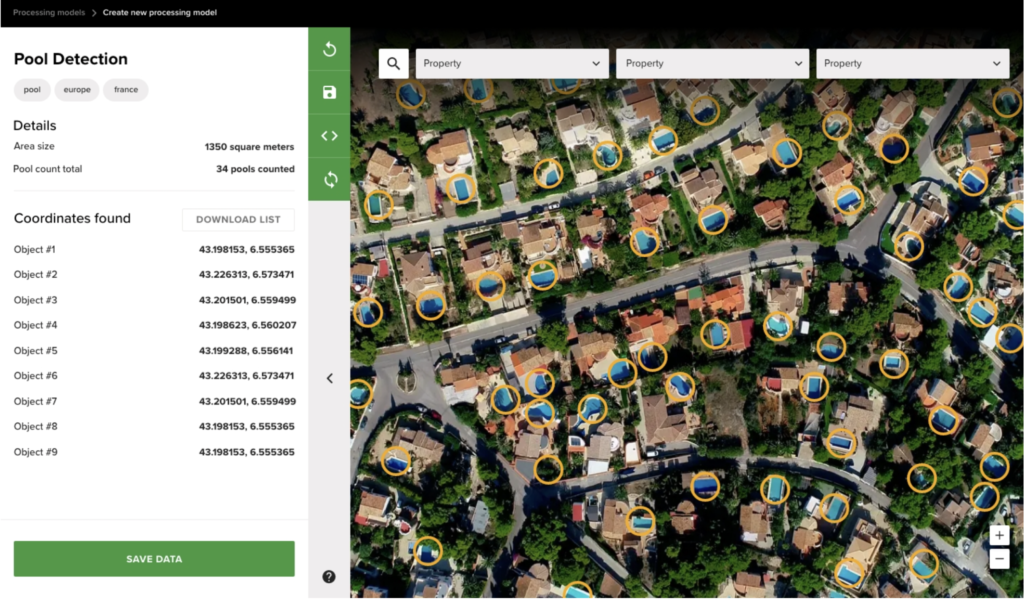As Elon Musk said “space is hard” and even though SPOT-1, the first commercially purposed satellite dedicated to Earth Observation was launched back in February 1986, some of the big milestones to make EO data easily accessible to the public were only achieved recently (especially compared to more traditional industries).
A significant market barrier was only removed when the US government relaxed DigitalGlobe’s commercial license restrictions and authorized 0.3m resolution imagery to be sold commercially, this is when DigitalGlobe could launch WorldView-3 in August of 2014. Planet, one of the most significant companies in commercial earth observation, announced only in 2017 that its mission (to image the Earth daily) was complete.
Innovations like these provide the resolution and frequency that is necessary for any modern ML (machine learning) based processing of earth observation data so it is understandable why most people who are not directly involved with this industry still assume that earth observation data based solutions are still the privilege of the military or some select government organizations. However, that is not the case anymore and there are new and innovative players coming to the space to revolutionize data-based decision-making.
Use cases for ML-based EO processing
Accessibility to data is important, however, it is not the data itself that is important, it is what you allow customers to do with data that really matters. The true value in any monetized data product is how that data tells the customer to do something and why.
The role that data science plays within the flow of data is to work with customers, partners and developers to provide the data value to the end users. Data analytics services automate the majority of this process, providing access to the data in a way that enables organizations to move seamlessly from the data set to decision-making, with a lower level of manual intervention on the data itself.
To simplify a bit what we are actually talking about, you can imagine a webpage where you can:
- Enter your preferred coordinates or area you want to examine
- Set the timeframe (resolution and frequency is important of course)
- Then select a processing method, like “watch for changes on my building site”, “count the number of cars using this parking area” or “identify objects around this oil line”
We saw this commercialization of data access and processing happen in many industries before but on the satellite data market potential buyers still greatly overestimate the costs associated with such a project and there is still a general assumption that high quality and use-case-specific EO data is only available to defense and governance-related projects.

So, here are some of the most popular use cases:
- Insurance and Finance: Analyse assets and verify claims, early warning notifications, portfolio risk (weather and geohazard)
- Land Management: Optimise land, use zoning, track changes over time
- Energy and natural resource management: including oil and gas monitoring and managing pipelines, detect natural oil seeps
- Infrastructure: Protect high-value assets, determine risk factors
- Transportation: Count cars, trucks, planes, traffic.. etc.
- Real Estate: Spatial analysis, urban area tracking
- Maritime: Monitor ships and cargo, harbour traffic
- Forestry: Monitor and manage forests, Detect Vegetation Encroachment
- Agriculture: Identify and monitor crop health, yield, fertiliser distribution.. etc.
And now let’s look into some more detailed examples:
Real Estate Development for say new retail can use satellite data to examine traffic flows in the area and better inform decisions regarding capacity required for parking and likely footfalls. Insurance companies and other financial institutions are major backers of retail development.
Insurers, Reinsurers use processed EO data to understand potential losses arising from events in a much faster way than previously possible to more quickly calculate the Capital required to meet losses.
Commodities brokers concerned with crop yields and therefore commodity values can use satellite data to examine crop growth and signs of pathogens to better inform pricing in the market.
Application Example: Finance & Insurance
Using Machine Learning based processing in a financial context is certainly not new, as we mentioned in one of our earlier articles ML based credit scoring was probably one of the first widely used ML applications back in the 90s. However, applying ML to EO data is certainly a recent trend.
Such satellite data is increasingly being used by both financial services and insurance companies to identify faster market opportunities and business risks. The use of satellite data for financial services provides the opportunity to anticipate the market and make better decisions with high-quality analytics:
- It bridges information gaps and activity in non-transparent markets
- Signal analysis enables the data to be combined with mainstream data to quickly address changing markets
- Satellite data allows strategic assets to be monitored for risk or as part of due diligence
The use of satellite data within the insurance industry offers a build on their traditional data approach to feed pricing models, validate claims, and identify new markets where examples include:
- Disaster Risk Assessment
- Risk Mitigation
- Parametric Insurance
- Crop Insurance
For example, specific weather-related API’s are already being actively used by insurance companies. Weather platforms like “Időkép” or “Ubimet” provide paid access to detailed thunderstorm and lightning databases that allow insurance companies to cross-check and validate insurance claims through system integrations.
Modern ML-based solutions can fill in a really similar role but with much more advanced data processing and integration capabilities and even offer custom data collection opportunities which result in a much better ROI long term.

Market predictions
To drive my point home about the market opportunity, please allow me to quote the European Union Agency For the Space Programme:
“EO (earth observation) revenues for data and services are forecast to double from roughly €2.8 billion to over €5.5 billion over the next decade. In 2021, over half of global revenue was generated by the top five segments: Urban Development and Cultural Heritage, Agriculture, Climate Services, Energy and Raw Materials, and Infrastructure. It is forecast that the Insurance and Finance segment (i.e. €145 m and 5.2% in 2021) will realise substantial growth over the next decade and become the largest contributor to global EO revenues in 2031 (with. €995 m and an 18.2% market share), boosted by the growing use and demand for parametric insurance products in the context of disaster resilience frameworks.
The EO value-added services market is considerably larger and accumulated globally a total of €2.2 bn in 2021 within the same scope of market segments. From 2021, the EO value-added services market will see a CAGR of 6.8%, resulting in €4.7 bn total revenues by 2031.
…each segment’s market share growth is illustrated over the 2021-2031 timeframe for both data and value-added service revenues, the Insurance and Finance segment is expected to experience the fastest growth over the next decade.”
Source: EUSPA – European Union Agency For the Space Programme, Earth Observation Market Report, Jan 25, 2022
Besides the latest market reports such as the one quoted above you can also also see that private-sector funding in space-related companies topped $10 billion in 2021—an all-time high and about a tenfold increase over the past decade. It is easy to see that the space economy is a booming hot topic followed by a rapidly increasing interest, satellite imagery and earth observation data is more easily accessible and readily available than ever before yet there is still a relatively small number of companies offering a commercial platform that could process the available data and satisfy the needs of a wider target audience at the same time.
If you are curious how such data processing can be achieved in for example Google Tensor flow, how ML models can be scaled into production, how to get access to custom EO data, please feel free to get in touch with us.
I can already tell that this topic resulted in some of the most exciting discussions in my career as each person brought in a new possible use case and application that truly shows that with the current technology, the options are limitless.